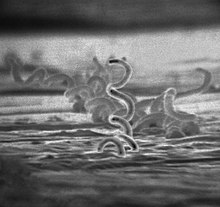| Treponema pallidum | |
|---|---|

| |
| Scientific classification | |
| Domain: | Bacteria |
| Phylum: | Spirochaetota |
| Class: | Spirochaetia |
| Order: | Spirochaetales |
| Family: | Treponemataceae |
| Genus: | Treponema |
| Species: | T. pallidum
|
| Binomial name | |
| Treponema pallidum | |
Treponema pallidum, formerly known as Spirochaeta pallida, is a microaerophilic, gram-negative, spirochaete bacterium with subspecies that cause the diseases syphilis, bejel (also known as endemic syphilis), and yaws.[1] It is known to be transmitted only among humans and baboons.[2] T. pallidum can enter the host through mucosal membranes or open lesions in the skin and is primarily spread through sexual contact.[3] It is a helically coiled microorganism usually 6–15 μm long and 0.1–0.2 μm wide. T. pallidum's lack of both a tricarboxylic acid cycle and processes for oxidative phosphorylation results in minimal metabolic activity.[4] As a chemoorganoheterotroph, Treponema pallidum is an obligate parasite that acquires its glucose carbon source from its host. Glucose can be used not only as a primary carbon source but also in glycolytic mechanisms to generate ATP needed to power the bacterium given its minimal genome.[5] The treponemes have cytoplasmic and outer membranes. Using light microscopy, treponemes are visible only by using dark-field illumination. T. pallidum consists of three subspecies, T. p. pallidum, T. p. endemicum, and T. p. pertenue, each of which has a distinct related disorder. The ability of T. pallidum to avoid host immune defenses has allowed for stealth pathogenicity.[6] The unique outer membrane structure and minimal expression of surface proteins of T. pallidum has made vaccine development difficult. Treponema pallidum can be treated with high efficacy by antibiotics that inhibit bacterial cell wall synthesis such as the beta-lactam antimicrobial penicillin-G.[7]
- ^ Radolf JD, Deka RK, Anand A, Šmajs D, Norgard MV, Yang XF (10 October 2016). "Treponema pallidum, the syphilis spirochete: making a living as a stealth pathogen". Nature Reviews. Microbiology. 14 (12): 744–759. doi:10.1038/nrmicro.2016.141. ISSN 1740-1534. PMC 5106329. PMID 27721440.
- ^ "ClinicalKey". www.clinicalkey.com. Retrieved 12 November 2024.
- ^ Radolf JD (1996), Baron S (ed.), "Treponema", Medical Microbiology (4th ed.), Galveston (TX): University of Texas Medical Branch at Galveston, ISBN 978-0-9631172-1-2, PMID 21413263, retrieved 7 November 2024
- ^ Norris SJ, Cox DL, Weinstock GM (3 January 2001). "Biology of Treponema pallidum: correlation of functional activities with genome sequence data". Journal of Molecular Microbiology and Biotechnology. 3 (1): 37–62. ISSN 1464-1801. PMID 11200228.
- ^ Brautigam CA, Deka RK, Liu WZ, Norgard MV (2016). "The Tp0684 (MglB-2) Lipoprotein of Treponema pallidum: A Glucose-Binding Protein with Divergent Topology". PLOS ONE. 11 (8): e0161022. Bibcode:2016PLoSO..1161022B. doi:10.1371/journal.pone.0161022. ISSN 1932-6203. PMC 4990184. PMID 27536942.
- ^ Radolf JD, Deka RK, Anand A, Šmajs D, Norgard MV, Yang XF (December 2016). "Treponema pallidum, the syphilis spirochete: making a living as a stealth pathogen". Nature Reviews. Microbiology. 14 (12): 744–759. doi:10.1038/nrmicro.2016.141. ISSN 1740-1526. PMC 5106329. PMID 27721440.
- ^ Gartlan WA, Rahman S, Pellegrini MV, Reti K (2024), "Benzathine Penicillin", StatPearls, Treasure Island (FL): StatPearls Publishing, PMID 29939545, retrieved 12 November 2024